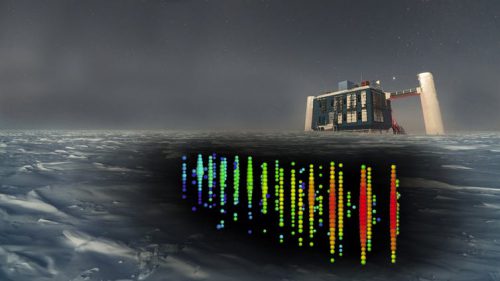The source is an active black hole at the center of a galaxy 3.7 billion light-years away * Prof. Dafna Guetta from the Physics Department at the Academic College of Engineering in Rauda, who is participating in the project, says that the discovery solved a question in the field of astrophysics that was still open to this day

Neutrinos, the ghost particles that barely make contact with normal matter, have previously been observed to come from supernovae (exploding stars) and the Sun. Now the giant IceCube detector at the South Pole has discovered that even blazars, galaxies with a massive black hole at their center, produce neutrino particles with an intensity millions of times stronger than that of supernovae and stars.
About 3.7 billion years ago, when the Earth was still in its infancy, radiation erupted from a black hole billion times more massive than the Sun in a jet that made its way and met the Earth on September 22, 2017.
This is the first time a neutrino source has been discovered in over 30 years. Moreover, this is the first time scientists have been able to observe high-energy neutrinos associated with a specific astrophysical event. The observation was published in the journal Nature last week.
Neutrino particles (from Italian: "small neutron") are elementary particles, without an electric charge and with a tiny mass that move at a speed very close to the speed of light and can usually pass through normal matter without interference. This feature allows astronomers and astrophysicists to obtain information from places that cannot be directly measured with other tools. On the other hand, this feature of neutrinos makes detection very difficult, which is why they are also called "ghost particles". Indeed, as mentioned, until recently the origin of the neutrinos was never identified.
One such neutrino particle known as IceCube-170922A, which was discovered as mentioned on September 22, 2017 in the ice cap in Antarctica, sent the IceCube researchers, among them Prof. Daphne Guetta from the Department of Physics at the Academic College of Engineering in Rouda, on a frantic search for its origin in the universe. The answer was found by NASA's Fermi Gamma-ray Space Telescope, which detected gamma radiation from the same source from which the neutrino came - a supermassive black hole of the blazar type whose jet of radiation is directed towards Earth at a distance of 3.7 billion light years from Earth Earth is at the center of an active galaxy.
The IceCube project was established at the exact point of the South Pole to monitor neutrino activity and consists of a square kilometer of sophisticated optical detectors located at a depth of a kilometer in the Antarctic ice sheet. Already in 2013, IceCube's detectors detected cosmic neutrinos with high energies for the first time and an alert was sent to observatories around the world in order to identify the source of the flux that is hitting the Earth, but without success. Now that the origin of IceCube-170922A has been discovered, a re-analysis of the neutrinos' trajectories discovered in 2013 has been carried out and it has been found that they also originate from the same cosmic particle accelerator, located in the heart of a distant galaxy.
Prof. Guetta previously had a permanent position at the University of Rome. In 2011 she moved to Israel for family reasons, and was accepted to the academic college in Rauda.
"Since the beginning of my career, I have been researching the neutrino particles with high energies. I started the research with Prof. Eli Waxman from the Weizmann Institute and then continued on my own, and from time to time I also research together with him and Prof. Ehud Bacher from the Technion, but today most of her research is done in collaboration with IceCube project researchers."

"The power of the neutrino is a million times higher than the power of the most powerful particle accelerator in the world. Imagine what can be done if we manage to find out how nature produces such energy." Prof. Guetta explains.
"The neutrino particles have very high energies of trillions of electron volts, thousands to millions of times higher than those of the supernova event, of the nuclear reactions in the sun or of the most powerful particle accelerators on Earth. "For over a century since the discovery of cosmic radiation, researchers have tried to discover its origin without success, for this purpose they established the IceCube project. After the discovery, we know of one source of neutrinos, which also indicates the presence of protons in that source, and this is an indication that there is material with mass there - something physical, not just a magnetic field and electrons.
"We know that cosmic radiation exists at high energies. For years experiments were conducted to locate the source of cosmic radiation but they failed to locate the sources. Cosmic radiation consists of charged protons. Because they have a charge we lose our direction, because they are magnetic and because they have mass they sometimes don't reach us.
Neutrino particles, on the other hand, have no mass and no charge, so it is possible to reconstruct their origin and also understand the processes that caused the explosion. Until today there was a dispute as to whether they are dispersed equally in all directions or whether they are concentrated in a jet that happens to be facing us. Since the discovery of a high-energy neutrino flux in 2013, experimenters have been trying to locate events in which both energetic neutrino particles and gamma rays are recorded, and this is what happened this time. Both the Fermi Space Telescope, which detects gamma-ray bursts, and IceCube located the source.

An open question in astrophysics
Prof. Guetta explains that the source of the radiation is an active nucleus of a galaxy, meaning that the black hole devours matter from its surroundings, some of it enters the black hole and is swallowed up inside it, but some of the matter comes out as a jet of radiation that we see both in the gamma range and as neutrinos.
"Until today we didn't know what the jet was made of. Astrophysicists had many theories on the subject. There are those who say that the jet is only made of a magnetic field and electrons and others, including me, argued that the jet must be composed of baryonic matter (ordinary AB matter). Neutrinos are by-products of protons, so what was emitted from the distant galaxy and reached us originates from kinetic energy, and not just electromagnetic radiation."
"This is a new era in astronomy, the discovery gives a new dimension to the study of the universe" says Prof. Guetta. "The discovery of additional sources of neutrinos will actually allow the creation of a map of cosmic ray accelerators and advanced research on their activity, which is why this discovery is so important to science. This is a new era in astronomy. The discovery gives a new dimension to the study of the universe", concludes Prof. Guetta.
News about the discovery on The Conversation website
A new window to The Conversation universe
More of the topic in Hayadan:
- Neutrinos with ice
- Particles from space deep in the ice (Report on the discovery from 2013)
- An Unfolding Mystery: One Hundred Years of the Discovery of Cosmic Radiation
- A universe of particles

8 תגובות
L. A. Ben Ner
You are right, mass is really equal to energy, but... it is not possible that on one side of the article it says that Natrino has mass, and on the other side of the article there is no mass. I responded to this contradiction and wrote that there is a Natrino mass (or if you want energy)
good day everybody
Yehuda
Lesbadramish, Doc and Herzl
Your discussion of the neutrino mass is anachronistic and unnecessary.
After all, in particle physics, mass and energy are two ways of presenting the same physical essence, and they are usually measured in the same units, electron-volt (ev), which can also be expressed in units of mass (kg, gr, etc.) according to the well-known Einstein formula E=mC ^2.
The treatment of mass as a physical concept is different from energy, which belongs to classical physics, where, as we know, the neutrino does not exist.
To illustrate: eV 1.0 = 1.782661907*10^-36 kg
(The figure is taken from Wikipedia).
To be precise, the mass product between the two neutrinos exists and the third is still unknown.
Judah is right. Only the mass is so small that the neutrino arrived close to the arrival of the X-rays, which indeed have no mass, so they managed to link the neutrino and the X-rays to the same source. If the neutrino had a larger mass, it would have arrived much later, and it is possible that the blazar source would have already relaxed and could not be associated.
Sabdarmish Yehuda,
This also made me wonder why, on the one hand, a minimal mass is recorded, and on the other hand, no mass.
The article must be edited.
Is there a way to create an electromagnetic energy envelope that suppresses the black hole's gravity
What do you care what is in the universe anyway you have no control over these matters. Leave the universe and invest all the resources in the world for the good of humans and the good of the planet. Make sure the humans have food and medicine and a place to live for education and fun recreation and basic technology to use. It's a shame for all the money and resources you spend on exploring the universe. All human beings want to live in ease and pleasure and they will not be helped by what is and what is not in the universe. There is no need to constantly strive for advanced technology, basic technology that helps people is enough.
In one place in the article it is written that the natrino particle has mass and in another place it does not, so that means that the natrino has mass. In 2015 two researchers, the Japanese Takaki Kajita and the Canadian Arthur McDonald, won the Nobel Prize in Physics for proving that the natrino has mass.
Good Day
Sabdarmish Yehuda